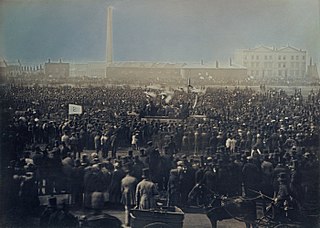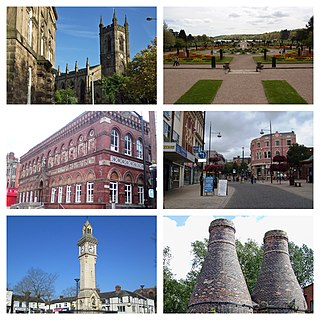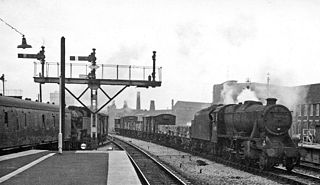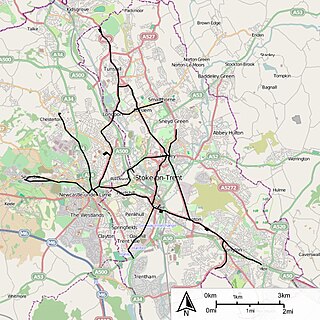Related Research Articles

Chartism was a working-class movement for political reform in the United Kingdom that erupted from 1838 to 1857 and was strongest in 1839, 1842 and 1848. It took its name from the People's Charter of 1838 and was a national protest movement, with particular strongholds of support in Northern England, the East Midlands, the Staffordshire Potteries, the Black Country and the South Wales Valleys, where working people depended on single industries and were subject to wild swings in economic activity. Chartism was less strong in places, such as Bristol, that had more diversified economies. The movement was fiercely opposed by government authorities, who finally suppressed it.

Stoke-on-Trent is a city and unitary authority area in Staffordshire, England, with an area of 36 square miles (93 km2). In 2021, the city had an estimated population of 258,400. It is the largest settlement in Staffordshire and is surrounded by the towns of Newcastle-under-Lyme, Alsager, Kidsgrove and Biddulph, which form a conurbation around the city.

Feargus Edward O'Connor was an Irish Chartist leader and advocate of the Land Plan, which sought to provide smallholdings for the labouring classes. A highly charismatic figure, O'Connor was admired for his energy and oratory, but was criticised for alleged egotism. His newspaper Northern Star (1837–1852) was widely read among workers, becoming the voice of the Chartist movement.

Josiah Spode was an English potter and the founder of the English Spode pottery works which became famous for the high quality of its wares. He is often credited with the establishment of blue underglaze transfer printing in Staffordshire in 1781–84, and with the definition and introduction in c. 1789–91 of the improved formula for bone china which thereafter remained the standard for all English wares of this kind.

Hanley is one of the six towns that, along with Burslem, Longton, Fenton, Tunstall and Stoke-upon-Trent, amalgamated to form the City of Stoke-on-Trent in Staffordshire, England.

Fenton is one of the six towns that amalgamated with Hanley, Tunstall, Burslem, Longton and Stoke-upon-Trent to form the county borough of Stoke-on-Trent in 1910, later raised to city status in 1925. Fenton is often referred to as "the Forgotten Town", because it was omitted by local author, Arnold Bennett, from many of his works based in the area, including one of his most famous novels, Anna of the Five Towns. It is in the ceremonial county of Staffordshire, England

The Staffordshire Potteries is the industrial area encompassing the six towns Burslem, Fenton, Hanley, Longton, Stoke and Tunstall, which is now the city of Stoke-on-Trent in Staffordshire, England. North Staffordshire became a centre of ceramic production in the early 17th century, due to the local availability of clay, salt, lead and coal.

Burslem is one of the six towns that along with Hanley, Tunstall, Fenton, Longton and Stoke-upon-Trent form part of the city of Stoke-on-Trent in Staffordshire, England. It is often referred to as the "mother town" of Stoke on Trent.
Arthur Berry was an English playwright, poet, teacher and artist, who was born in Smallthorne, Stoke-on-Trent. His individual creative work became deeply rooted in the culture, people and landscape of the industrial pottery town of Burslem.
Etruria is a suburb of Stoke-on-Trent, Staffordshire, England.

Tunstall is one of the six towns that, along with Burslem, Longton, Fenton, Hanley and Stoke-upon-Trent, amalgamated to form the City of Stoke-on-Trent in Staffordshire, England. It was one of the original six towns that federated to form the city. Tunstall is the most northern, and fourth largest town of the Potteries. It is situated in the very northwest of the city borough, with its north and west boundaries being the city limit. It stands on a ridge of land between Fowlea Brook to the west and Scotia Brook to the east, surrounded by old tile-making and brick-making sites, some of which date back to the Middle Ages.

Longton is one of the six towns which amalgamated to form the county borough of Stoke-on-Trent in 1910, along with Hanley, Tunstall, Fenton, Burslem and Stoke-upon-Trent. It is in the ceremonial county of Staffordshire, England.

The Potteries Loop Line was a railway line that connected Stoke-on-Trent to Mow Cop and Scholar Green via Hanley, Burslem, Tunstall and Kidsgrove. It ran between Staffordshire and Cheshire in England. It served three of the six towns of Stoke on Trent. It was opened in many short sections due to the cost of railway construction during the 1870s. The line throughout was sanctioned but the North Staffordshire Railway felt that the line would be unimportant enough to abandon part way through its construction. This upset residents of the towns through which the line was planned to pass and they eventually petitioned Parliament to force the completion of the route.

Samuel Alcock (1799–1848) was a leading English pottery manufacturer who operated as Samuel Alcock & Co in Burslem, Staffordshire from 1828 to 1859. They were especially noted for "picture jugs" modelled and moulded in relief in various ceramic materials, a popular type of object in these years.
The federation of Stoke-on-Trent was the 1910 amalgamation of the six Staffordshire Potteries towns of Burslem, Tunstall, Stoke-upon-Trent, Hanley, Fenton and Longton into the single county borough of Stoke-on-Trent. The federation was one of the largest mergers of local authorities, involving the greatest number of previously separate urban authorities, to take place in England between the nineteenth century and the 1960s. The 1910 federation was the culmination of a process of urban growth and municipal change that started in the early 19th century.
Predominantly centred on Hanley and Burslem, in what became the federation of Stoke-on-Trent, the 1842 Pottery Riots took place in the midst of the 1842 General Strike, and both are credited with helping to forge trade unionism and direct action as a powerful tool in British industrial relations.

The Potteries Electric Traction Company operated a tramway service in The Potteries between 1899 and 1928.
The Staffordshire Potteries Street Railway operated a horse-drawn tramway service between Hanley and Burslem from 1862 to 1880.
The North Staffordshire Tramways operated a steam tramway service from 1881 to 1898 in the Staffordshire Potteries area.
Colin Melbourne was an English sculptor, ceramicist, painter and academic. He is known particularly for several statues that stand in various locations in Stoke-on-Trent.
References
- ↑ "The Operative" The issue for 20 January 1839
- ↑ letter written 12 June 1842 by Jeremiah Yates to Thomas Cooper found in Cooper's house when he was arrested in August 1842
- ↑ The Staffordshire Examiner, 20 August 1842
- ↑ The Life of Thomas Cooper' Hodder and Stoughton
- ↑ North Staffordshire Mercury, 27 August 1842
- ↑ North Staffordshire Mercury, 27 August 1842
- ↑ The Northern Star, 17 Dec 1842
- ↑ John Ward, The history of the Borough of Stoke-on-Trent, 1843.
- ↑ NS 11 Nov 1843 under Chartist Intelligence
- ↑ North Staffordshire Mercury, 18 May 1844
- ↑ Obituary in the Staffordshire Advertiser, Saturday, 16 October 1852.
- ↑ The Staffordshire Advertiser, 23 October 1852